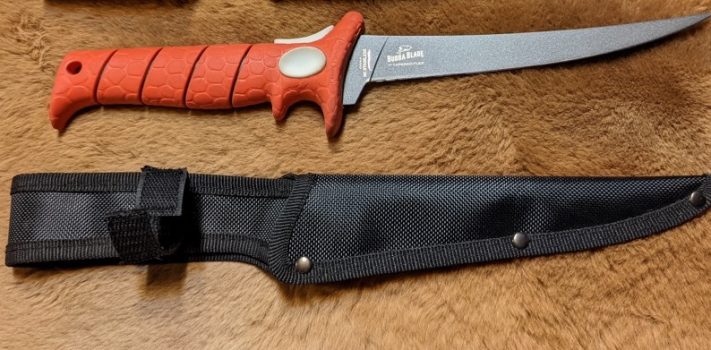It is said that even a blind squirrel finds a nut every now and then. I have some nutty discoveries to pass along. These discoveries do not merit 1,500 words individually. Collectively, they may deserve some attention. I have compiled them into a single article for your edification and entertainment.
Fire Starting
Cadillac Mink Oil
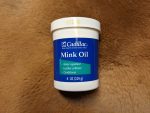 Mink oil is a byproduct of the fur industry, obtained by rendering the insulating fatty layer found under the skin of minks. It is more resistant to rancidity than most other animal and vegetable oils. It is used as a skin moisturizer and in other cosmetics, as a treatment to make leather more pliable and waterproof, as a biofuel, as lubrication for black powder patches, and as a case lube for reloading. As a biofuel, it produces more energy per unit than most other animal fats.
Mink oil is a byproduct of the fur industry, obtained by rendering the insulating fatty layer found under the skin of minks. It is more resistant to rancidity than most other animal and vegetable oils. It is used as a skin moisturizer and in other cosmetics, as a treatment to make leather more pliable and waterproof, as a biofuel, as lubrication for black powder patches, and as a case lube for reloading. As a biofuel, it produces more energy per unit than most other animal fats.
I recently ran across an 8 ounce jar of mink oil at a thrift store for 50 cents. That is a great deal. The cheapest I was able to find a similar jar elsewhere was for $6.95 on eBay.
As a dedicated kindler of campfires (pyromaniac), one of my first questions was, “How well does this stuff burn?” One of my favorite tinders is a cotton ball dabbed with petroleum jelly. I wondered how mink oil would compare with petroleum jelly as an accelerant when used in conjunction with a cotton ball.
Two times I put a dab of mink oil on a cotton ball, and then ignited the cotton ball with a ferrocerium rod. Both times I got the same results. The mink oil burned much faster than is typical for petroleum jelly. A dab of petroleum jelly will typically burn for two to three minutes. The mink oil will typically be consumed in about a minute. During that minute, the flame will typically be larger and hotter than would be the case for petroleum jelly. The mink oil also produces a subtle, vaguely unpleasant odor as it burns. The smell is not overpowering, but it is noticeable.
All in all, I prefer the more consistent, slower burn of petroleum jelly. Petroleum jelly is also typically available at a lower cost than mink oil. But if mink oil is all that you have available, it should do a good job.
Guitar Picks and Damp Tinder
I recently wrote an article about making waterproof tinder. It was published on SurvivalBlog on June 6, 2021. In a note on the article, JWR observed: “One sure way to get even a damp tinder packet going is by attaching a standard celluloid guitar pick. Celluloid burns hot and fast. If its edges are roughed up with a knife, then a guitar pick can be easily ignited with a ferro rod. The burning pick will in turn ignite your tinder packet. I’ve found that celluloid guitar picks are available inexpensively in bulk (by the hundred) on eBay.”
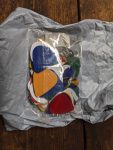 This intriguing comment demanded further investigation, so I went on eBay and found “100pcs Guitar Picks Acoustic Electric Plectrums Celluloid Assorted Colors” for $3.36 plus free shipping. I placed the order, and a couple of weeks later received a package of guitar picks in the mail. I selected one pick at random, and attempted to rough up an edge with a knife. The edge of the knife tended to slide harmlessly along the edge of the pick. Instead, I finally cut fuzz-stick-like peelings along the edge of the pick. I then folded it in half like a tent, and attempted to light it with a ferrocerrium rod. The thin ends of some of the peelings would show signs of ignition, and then self extinguish.
This intriguing comment demanded further investigation, so I went on eBay and found “100pcs Guitar Picks Acoustic Electric Plectrums Celluloid Assorted Colors” for $3.36 plus free shipping. I placed the order, and a couple of weeks later received a package of guitar picks in the mail. I selected one pick at random, and attempted to rough up an edge with a knife. The edge of the knife tended to slide harmlessly along the edge of the pick. Instead, I finally cut fuzz-stick-like peelings along the edge of the pick. I then folded it in half like a tent, and attempted to light it with a ferrocerrium rod. The thin ends of some of the peelings would show signs of ignition, and then self extinguish.
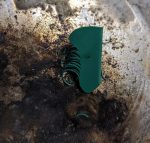 I next attempted to light the pick with a permanent metal match. The end of the pick would melt and char, but it would not ignite. I repeated the attempt with a plasma lighter. Finally, I repeated the attempt with a second pick. All of these attempts were without success. The picks appear to be made of some material other than celluloid, perhaps nylon.
I next attempted to light the pick with a permanent metal match. The end of the pick would melt and char, but it would not ignite. I repeated the attempt with a plasma lighter. Finally, I repeated the attempt with a second pick. All of these attempts were without success. The picks appear to be made of some material other than celluloid, perhaps nylon.
With that in mind, I contacted the seller to request a refund, and received it later the same day.
A Norwegian saying goes, “A burned cat avoids the fire.” Having been burned once, I was hesitant to order from eBay again. I decided to talk to our senior pastor, who plays the guitar, about the best place to get cheap celluloid guitar picks.
Our senior pastor had a box of extra guitar picks that someone had given to him. He invited me to go through it and help myself. Most of the picks appeared to be made of nylon. There were some that I thought might be celluloid, so I took a couple of samples outside in the parking lot and attempted to ignite them with a plasma lighter. The attempt was unsuccessful. They were evidently not made of celluloid either.
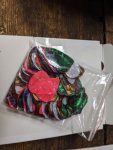 Next, I placed an order with an online vendor suggested by our senior pastor for 200 celluloid picks at a total cost of $12.90. I suspected that the picks were genuine celluloid, since online reviewers complained of an odor, which resembled Vicks Vaporub. Celluloid is composed of a mixture of nitrocellulose (gun cotton) and camphor. Since camphor is the principle ingredient in Vaporub, I thought the camphor in the celluloid might give the picks a Vaporub-like odor. Six days later, my order arrived. I had the order shipped to my office, since I am usually there during the day. I quickly took one of the picks out to the parking lot and attempted to ignite it with a plasma lighter. It lighted quickly, and burned vigorously.
Next, I placed an order with an online vendor suggested by our senior pastor for 200 celluloid picks at a total cost of $12.90. I suspected that the picks were genuine celluloid, since online reviewers complained of an odor, which resembled Vicks Vaporub. Celluloid is composed of a mixture of nitrocellulose (gun cotton) and camphor. Since camphor is the principle ingredient in Vaporub, I thought the camphor in the celluloid might give the picks a Vaporub-like odor. Six days later, my order arrived. I had the order shipped to my office, since I am usually there during the day. I quickly took one of the picks out to the parking lot and attempted to ignite it with a plasma lighter. It lighted quickly, and burned vigorously.
Later that evening, I went out to the barn for further testing. I took a pick, cut the edges like a fuzz stick, folded it in half like a tent, and attempted to light it with a ferrocerium rod. It lit well, and burned vigorously.
Next I took a cotton ball, immersed it in a can of water, and then wrung out as much water as I could. I fluffed the damp cotton, and put a dab of petroleum jelly on it. Then I prepared a pick like a fuzz stick, and ignited it with a ferrocerium rod under the cotton tinder. The pick burned vigorously, but did not dry the damp tender sufficiently to ignite it. I then attempted the process several more times without success.
Next, I tried putting the petroleum jelly directly on the pick, and the pick on top of the cotton. This attempt also failed.
Finally, I took about ten picks and folded each of them in half like a tent. I added a larger amount of petroleum jelly to the cotton than usual. I ignited a pick under the cotton, added a second pick before the first pick could go out, and continued to add picks to the fire until all ten were consumed. This dried the cotton tinder enough to ignite. It then burned well for several minutes.
So a number of burning celluloid picks will produce enough heat to dry a thoroughly damp cotton ball sufficiently to allow it to be used as tinder.
Lip Balm
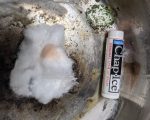 In a comment on an article in SurvivalBlog published on February 4, 2021, a reader named “Benjamin” stated, “Another great tinder idea, some of the softer lip balm sticks do a good job of embedding in cotton balls and will catch a spark pretty much like PJ does. Easier to carry.” I felt that this idea was worthy of further investigation, so when the end fell out of a lip balm tube recently, I put it aside for further testing. Eventually I took the lip balm remnant to the barn, fluffed a cotton ball, put the remaining lip balm on the cotton, and ignited it with a ferrocerrium rod. The ball burned brightly for about a minute and a half.
In a comment on an article in SurvivalBlog published on February 4, 2021, a reader named “Benjamin” stated, “Another great tinder idea, some of the softer lip balm sticks do a good job of embedding in cotton balls and will catch a spark pretty much like PJ does. Easier to carry.” I felt that this idea was worthy of further investigation, so when the end fell out of a lip balm tube recently, I put it aside for further testing. Eventually I took the lip balm remnant to the barn, fluffed a cotton ball, put the remaining lip balm on the cotton, and ignited it with a ferrocerrium rod. The ball burned brightly for about a minute and a half.
So if you ever need some tinder in a pinch, a cotton ball and some lip balm will serve the purpose.
Sterno Green FireStarter Instant Flame Gel
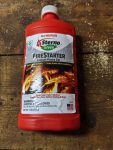 I ran across this product in a local big box store. At $4.97 for a 1 pound bottle, the price seemed reasonable, so I thought I would give it a try. Although the ingredients are not listed on the packaging, based upon the composition of Sterno’s other products, and based upon the characteristics of the flame produced by this material, I believe it to consist of jellied denatured ethanol. As compared with the standard cotton ball/petroleum jelly tinder, the Sterno product has certain advantages and certain disadvantages. A significant advantage is that the Sterno gel can be ignited directly with a ferrocerium rod without the assistance of a cotton ball. An appropriately sized dab can just be squirted wherever it is needed and ignited there.
I ran across this product in a local big box store. At $4.97 for a 1 pound bottle, the price seemed reasonable, so I thought I would give it a try. Although the ingredients are not listed on the packaging, based upon the composition of Sterno’s other products, and based upon the characteristics of the flame produced by this material, I believe it to consist of jellied denatured ethanol. As compared with the standard cotton ball/petroleum jelly tinder, the Sterno product has certain advantages and certain disadvantages. A significant advantage is that the Sterno gel can be ignited directly with a ferrocerium rod without the assistance of a cotton ball. An appropriately sized dab can just be squirted wherever it is needed and ignited there.
One disadvantage is that the flame produced by the Sterno gel is not as hot as that produced by a similar weight of cotton ball/petroleum jelly combo, and it does not last as long. The flame sputters quite a bit, hinting at some residual moisture within the gel.
A second disadvantage is that the Sterno gel would be more prone to leakage and evaporation than the components of the cotton ball/petroleum jelly combo.
Finally, the Sterno gel costs more per ounce than the components of the cotton ball/petroleum jelly combo.
So all in all, I would rate the Sterno gel as an okay product that may be conveniently packaged for home use, but I would not recommend it for field use.
Knives
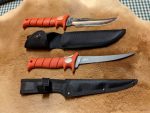 Recently, a missionary friend in Mexico sent me a couple of knives to try out. What could be better than a friend who will send you a couple of knives (each with a manufacturer suggested retail price close to $50) just for the fun of it? I am truly blessed.
Recently, a missionary friend in Mexico sent me a couple of knives to try out. What could be better than a friend who will send you a couple of knives (each with a manufacturer suggested retail price close to $50) just for the fun of it? I am truly blessed.
The Bubba Blade 7″ Tapered Flex Fillet Knife
This knife comes with an easy-to-grip, full-tang handle and an unlined nylon sheath with a velcro retention strap. The blade has an attractive grey titanium nitride finish. It arrived not quite as sharp as I could wish (it was too dull to shave the hair off my forearm), but some work with the Accusharp Diamond Pro 2 Step sharpener corrected that problem. The knife then found a new home in my tackle box.
On a recent camping trip, I forgot my hatchet. The Bubba Blade fillet knife was the best alternative I had on hand. I used it to baton kindling for my campfire. Batoning involves using a wooden baton to drive a knife blade through a piece of firewood in order to split it into smaller pieces.
I expected this process to destroy the relatively thin blade of this knife. That did not happen. I am very impressed with the durability of this blade.
I haven’t yet caught a fish large enough to justify the use of a seven inch fillet knife, so the jury is still out on the use of this knife for its intended purpose. But the blade is sharp and thin and durable, so I am optimistic.
The Bubba Blade 7″ Hunting Knife
The 7″ Hunting Knife has a huge and aggressive looking blade. It comes with a nylon sheath with a plastic lined snap closure retention strap. It has the same easy-to-grip, full-tang handle as the fillet knife. It came out of the box sharp enough to shave with.
Style-wise, I am not a big fan of this knife. It looks more like a caricature of a knife than the real thing. I might have liked it when I was in junior high, but my tastes have matured since then. I considered using it as a project knife, and reshaping the blade into something more agreeable to my current tastes, but decided against that. Instead, I put the knife in our camper. If I ever forget a hatchet again, I will have something heavier than a fillet knife to use as I baton kindling.
Disclaimer
I did not receive any financial or other inducements to mention any vendor, product, or service in this article.

